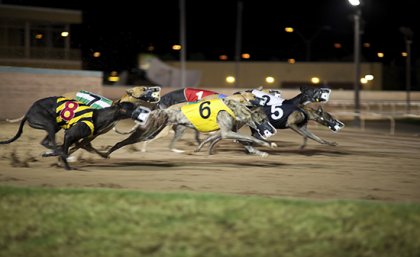
Australia’s greyhound industry is reeling from the ABC’s Four Corners expose, featuring graphic footage of racing dogs tearing other mammals apart in the illegal training practice of live baiting.
The Victorian government has announced an investigation into the latest revelations, and the Royal Society for the Prevention of Cruelty to Animals has urged other states to do likewise.
The incentive is the lure of big prize money, with the most successful dogs netting well over half a million dollars in career winnings. According to industry figures more than A$3.1 billion was wagered on Australian greyhound races in 2013-14, while unofficial estimates put the top trainers' earnings at up to A$5 million a year.
These financial rewards have spurred people to barbarity. The Four Corners program showed footage of some of Australia’s top trainers baiting dogs with rabbits, possums and piglets to make their dogs more eager to catch the artificial lures used in a race. Most of the bait animals were tied to the artificial lure in the training arenas, with dogs initially muzzled but then later unmuzzled and allowed to tear the creatures to pieces.
How will racing clean itself up?
The program suggested that the industry’s regulators either didn’t know this was happening or didn’t want to know. In the livestock sector the move towards industry self-regulation has been disastrous for its integrity. Self-regulation is the way out for squeamish governments.
Effective external regulation of the racing industry is essential to protect animal welfare. Animals Australia has called for financial support from government to be suspended and for government task forces to take over regulatory control. This may work in the short term, but in the long term we need statutory bodies governed by a board of independent people with expertise not just in the industry itself, but also in animal welfare, doping, relevant legislation and gambling.
Good corporate practice in Australia requires that there is a majority of independent members on a board who are not substantial shareholders, have not been employed within the company for the previous three years, are not advisers or suppliers to the company and have no contractual relationship with it. With this background board members will be able to act in the interests of society as a whole and not in their own individual interests.
Besides being governed with more integrity, the industry needs the capability to inspect facilities on a regular basis. Most are close to capital cities and can be easily reached. Again, inspectors need to be of high integrity and knowledgeable about, but not integrally connected to, the industry.
Hunting for prizes
Inside every dog, including greyhounds, lurks a hunter. They lived by this means for millions of years. The use of live baiting works by building a strong connection in the dog’s mind between the chase of a squeaking dummy and a live animal.
The greyhound racing industry evolved in the early part of the last century from hare coursing, replacing the prey with a mechanical “hare” moving around a track to avoid the needless killing of a defenceless animal. However, old habits die hard – on my first day at work at a British agricultural college I was taken by my boss to a hare coursing event to “toughen me up”. It didn’t work.
Australians have many passions, but sport, animals and betting all feature pretty strongly. That’s why, despite its small population, Australia has by some measures (see section 7 here) the largest greyhound racing industry in the world.
Fortunately in Australia we also have good animal cruelty legislation. Live baiting is illegal and the perpetrators will be prosecuted. As Four Corners pointed out, live baiting carries a sentence of up to two years in prison.
Spare a thought too for those that will have been emotionally affected by the allegations and scenes of abject cruelty brought to us on our television screens. The last major revelation of this nature, of live cattle being hacked to death in Indonesia, traumatised some people so much that they sought counselling.
Where next for racing?
The Indonesian cattle revelations brought an industry to its knees, but it has got back up and is now stronger than ever. The same will happen with the greyhound industry.
After this masterful exposé, access to greyhound training grounds will become practically off-limits to visitors. Access was probably legally off-limits already – training facilities are privately owned and the Four Corners program did not detail exactly how the cameras were installed by Animals Australia and Animal Liberation Queensland to capture the damning secret footage. Fences will be erected and the industry will attempt to protect itself against people that it will dub as extremists.
Two things must happen to curb the unethical behaviour that is clearly rife in this industry. First, the power is in the hands of the punter. Don’t bet on sports that involve cruelty to animals. If you must bet, bet on whichever of the myriad human sports appeals to you. The welfare of the participants is well provided for.
Second, the use of live baits to train greyhounds must be stamped out once and for all. The industry should not be allowed to retreat behind closed doors. It needs to understand it has to regain the trust of punters and the general public. The only way it can do this is by proving itself to be willing and capable of addressing endemic wrongdoing.
![]()
This article was originally published on The Conversation.
The views expressed in this article are not necessarily those of The University of Queensland.
.jpg)












